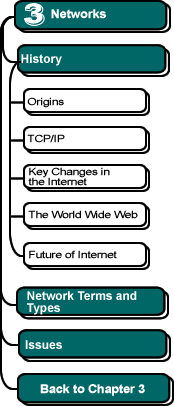

|
ARPANET
IPTO's solution to the incompatibility problem was to design special computers that would serve as interfaces through which other computers could be connected. They called this special kind of connecting computer an Interface Message Processor, or IMP, and awarded the contract for realizing the IPTO designs to BBN, a Boston-area computer company. (Massachusetts Senator Ted Kennedy sent a letter to BBN, congratulating them on their "interfaith message processor.")
 Most
of the IPTO research sites were universities. Accordingly,
the first two computers that IPTO attempted to connect using this new
network design scheme were one at Stanford University
in northern California and another at UCLA, in southern
California.
Most
of the IPTO research sites were universities. Accordingly,
the first two computers that IPTO attempted to connect using this new
network design scheme were one at Stanford University
in northern California and another at UCLA, in southern
California.
The computer system at UCLA was connected to an IMP there, which was in turn connected by "high-speed" (though slow by today's standards) phone lines to an IMP at Stanford, which was in turn connected to the computer at the Stanford Research Institute (SRI).
On a red-letter day in September 1969, the UCLA team attempted to log in to the computer system at Stanford. As one of the UCLA team members began typing in the "login" command, researchers 350 miles away at Stanford were delighted to see the letters appearing at their end. As the "g" in "login" was typed, the software in the IMPs crashed. But it had worked nonetheless!
This humble beginning, dubbed the ARPANET, would become the Internet.
![]()
![]()
This chapter was written by Jeff Nyhoff and Joel Adams. Copy editing by
Nancy Zylstra
©2005 Calvin University (formerly Calvin College), All Rights Reserved
If you encounter technical errors, contact computing@calvin.edu.